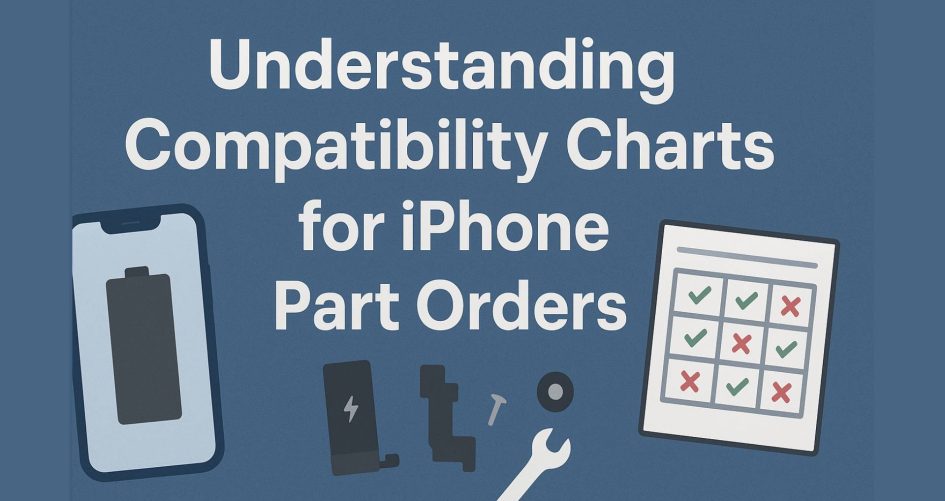In the fast-moving world of phone refurbishment, ensuring iPhone parts compatibility, using an accurate model chart repair, and maintaining perfect order accuracy can be the difference between a profitable job and a costly return. With Apple’s wide range of iPhone models—each with subtle hardware differences—knowing exactly which part fits which device is critical. This guide will walk you through how to read and apply compatibility charts so that your iPhone part orders are correct every single time. Know more.
Why iPhone Parts Compatibility Is So Important
The iPhone lineup might look similar from the outside, but internally, variations in display connectors, battery dimensions, camera modules, and flex cable configurations can cause major issues if the wrong component is installed.
Using an iPhone parts compatibility chart ensures that technicians can match each component to the correct device variant. When paired with a detailed model chart repair, these tools help minimize mistakes, improve efficiency, and boost order accuracy.
Common Challenges Without Compatibility Charts
Without a proper iPhone parts compatibility reference, refurbishers often face:
- Ordering parts for the wrong generation.
- Receiving components that fit physically but are not electronically compatible.
- Wasting time on returns and exchanges due to poor order accuracy.
- Incorrect repairs that lead to device failure and customer dissatisfaction.
A model chart repair eliminates these guesswork problems, providing clear mapping between part numbers, models, and specifications.
What Is a Model Chart Repair?
A model chart repair is essentially a reference table that matches every iPhone model to the correct replacement parts. It lists device model numbers (like A2342 for iPhone 12 Pro Max), component codes, and compatibility notes. For example, while iPhone 12 and iPhone 12 Pro share some iPhone parts compatibility, their camera modules differ significantly.
Using these charts is a proven method to keep order accuracy high, even when handling large wholesale orders.
Components That Require Strict iPhone Parts Compatibility Checks
- Displays – Connector type and flex cable arrangement may differ between models, even within the same series.
- Batteries – Variations in size, capacity, and connector placement.
- Cameras – Lens specifications and sensor alignment differ.
- Flex Cables – Small design changes can cause incompatibility.
- Logic Board Parts – Chipsets and connectors must match the exact model.
The more complex the repair, the more critical it is to use a model chart repair to maintain order accuracy.
How to Read an iPhone Compatibility Chart
A standard iPhone parts compatibility chart will include:
- Device Name & Year – iPhone 11 (2019), iPhone 14 Pro (2022), etc.
- Model Number – Axxx format found on the back of the device or in settings.
- Compatible Parts List – Display assemblies, batteries, cameras, charging ports, etc.
- Notes – Special considerations for model chart repair such as connector revisions or software calibration needs.
Example:
| iPhone Model | Model Number | Display Part No. | Battery Part No. | Notes |
| iPhone 12 | A2172, A2402 | D12-ASM | B12-LIT | Compatible with 12 Pro display but True Tone calibration required |
Using this approach ensures order accuracy across bulk shipments.
Best Practices for Using iPhone Parts Compatibility Charts
- Always Confirm the Model Number
Don’t rely solely on the iPhone’s name; multiple versions can exist within the same generation. This step alone improves order accuracy dramatically. - Keep Your Model Chart Repair Updated
Apple releases updated parts with small revisions. Using an outdated chart can lead to iPhone parts compatibility errors. - Cross-Check with Supplier Data
Your suppliers may have slightly different naming conventions. Match their part numbers against your model chart repair. - Train Your Team
Even experienced technicians can benefit from refresher sessions on reading compatibility charts.
Order Accuracy in Large-Scale Wholesale Operations
When dealing with hundreds or thousands of iPhones, order accuracy becomes even more crucial. A single iPhone parts compatibility mistake in bulk orders can result in significant delays and losses.
Using a centralized model chart repair that all staff can access reduces inconsistencies and improves workflow efficiency.
Digital Tools for iPhone Parts Compatibility
Modern refurbishers often integrate iPhone parts compatibility data into repair management software. These systems:
- Auto-suggest the correct part based on model number.
- Flag possible compatibility issues.
- Sync with supplier databases for improved order accuracy.
Some advanced platforms even allow for model chart repair updates in real time, ensuring technicians are always working with the latest information.
Mistakes to Avoid
- Guessing Based on Appearance – Two parts may look identical but have different internal connections.
- Ignoring Small Variants – Cellular bands, region codes, or mid-cycle hardware changes can affect iPhone parts compatibility.
- Not Verifying Before Ordering – Always match to the model chart repair before placing bulk orders.
Trends in Compatibility Chart Usage
The refurbishing industry is moving toward digital-first tools where iPhone parts compatibility data is stored in cloud-based platforms accessible from any repair station. This not only improves order accuracy but also makes it easier to handle complex model chart repair processes for newer models like iPhone 15 or upcoming iPhone 16.
Why Compatibility Charts Will Remain Essential
With Apple continuing to innovate, iPhone parts compatibility will only become more complex. A well-maintained model chart repair ensures your business avoids costly returns, maintains high order accuracy, and stays competitive in a demanding market.
Conclusion
In the phone refurbishment industry, iPhone parts compatibility is more than just a convenience—it’s a necessity. A reliable model chart repair process combined with strict order accuracy checks ensures every repair is successful the first time. As technology advances, adopting these tools will be essential for scaling your operations and keeping customers satisfied. Know more.





